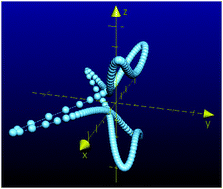On the origin of vorticity in magnetic particle suspensions subjected to triaxial fields
Abstract
We have recently reported that two classes of time-dependent triaxial magnetic fields can induce vorticity in magnetic particle suspensions. The first class – symmetry-breaking fields – is comprised of two ac components and one dc component. The second class – rational triad fields – is comprised of three ac components. In both cases deterministic vorticity occurs when the ratios of the field frequencies form rational numbers. A strange aspect of these fields is that they produce fluid vorticity without generally having a circulating field vector, such as would occur in a rotating field. It has been shown, however, that the symmetry of the field trajectory, considered jointly with that of the converse field, allows vorticity to occur around one particular field axis. This axis might be any of the field components, and is determined by the relative frequencies of the field components. However, the symmetry theories give absolutely no insight into why vorticity should occur. In this paper we propose a particle-based model of vorticity in these driven fluids. This model proposes that particles form volatile chains that follow, but lag behind, the dynamic field vector. This model is consistent with the predictions of symmetry theory and gives reasonable agreement with previously reported torque density measurements for a variety of triaxial fields.


 Please wait while we load your content...
Please wait while we load your content...